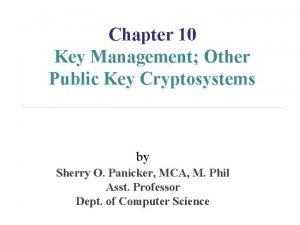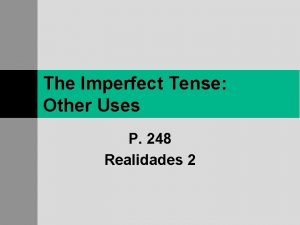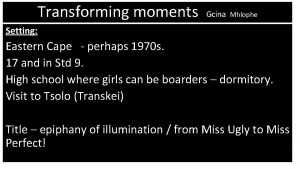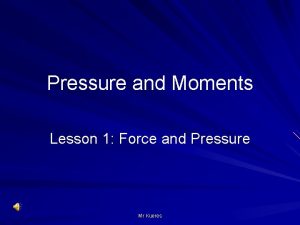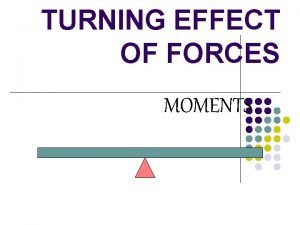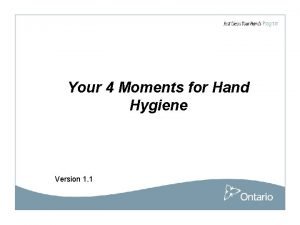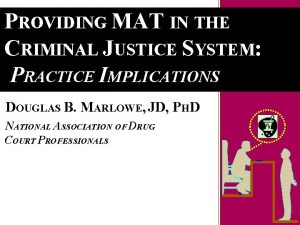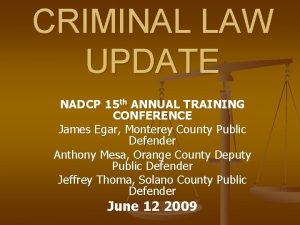DUI AND OTHER Key Moments in NADCP History

































- Slides: 33

DUI AND OTHER Key Moments in NADCP History TREATMENT DOCKETS: “BEST PRACTICES, BEST RESULTS” TERRENCE D. WALTON, MSW, CSAC CHIEF OPERATING OFFICER NATIONAL ASSOCIATION OF DRUG COURT PROFESSIONALS

Key Moments in NADCP Why Standards? 16%History Null Fidelity Courts Legislators Opponents Validity Identity Legality 9% Harmful Publicity Maturity Due Process Rational Basis Equal Protection

Why Standards? Key. Drug Moments NADCP History Until Courts definein appropriate standards 16% Null of practice, held accountable, fairly or Validity Fidelitythey will be 9% Harmful unfairly, for the worst practices in the field. Scientists will continue to analyze the effects of weak Drug Courts alongside those of exceptional Drug Courts, thus Courts diluting the benefits of Drug Courts. Critics will continue Identity Publicity Legislators to tarnish the reputation of Drug Courts by attributing Opponents to them the most noxious practices of the feeblest programs. Only by defining the bounds of acceptable Due Process and exceptional practices will Drug Courts be in a Rational Basis Maturity or harmful position. Legality to disown poor-quality programs Protection and set effective benchmarks for new. Equal and existing programs to achieve.

Key Moments in NADCP Volume I History I. Target Population II. Historically Disadvantaged Groups III. Roles & Responsibilities of the Judge IV. Incentives, Sanctions, & Therapeutic Adjustments V. Substance Abuse Treatment

Key Moments in NADCP Volume I History Twenty out of twenty-five states (80%) responding to a national survey indicated they have adopted the Standards for purposes of credentialing, funding, or training new and existing Drug Courts in their jurisdictions.

Key Moments in NADCP Volume II History VI. Complementary Treatment & Social Services VII. Drug and Alcohol Testing VIII. Multidisciplinary Team IX. Census and Caseloads X. Monitoring and Evaluation

Volume II 10 Big Things You Need to Know

Key Moments in NADCP History Complementary Treatment Participants receive complementary treatment and social services for conditions that co-occur with substance abuse and are likely to interfere with their compliance in Drug Court, increase criminal recidivism, or diminish treatment gains.

Key Moments in NADCP History Complementary Treatment • N = 21 reviewers high low 4. 57 4. 48 3. 81

Key Moments in NADCP History Complementary Treatment A. B. C. D. E. F. Scope of Services Sequence and Timing of Services Clinical Case Management Housing Assistance Mental Health Treatment Trauma-Informed Services

Key Moments in NADCP History Complementary Treatment G. H. I. J. K. L. Criminal Thinking Interventions Family & Interpersonal Counseling Vocational & Educational Services Medical and Dental Treatment Prevention of High-Risk Behaviors Overdose Prevention & Reversal

Complementary Treatment 1) Do not begin criminal thinking interventions during Phase 1. 2) Enlist at least one reliable prosocial family member, friend, or daily acquaintance to provide feedback to staff and assist participant.

Key Moments NADCP History Timingin. Matters Responsivit y Needs Criminoge nic Needs Maintenan ce Needs

Key Moments in NADCP History Drug & Alcohol Testing Drug and alcohol testing provides an accurate, timely, and comprehensive assessment of unauthorized substance use throughout participants’ enrollment in the Drug Court.

Key Moments in NADCP History Drug & Alcohol Testing • N = 36 reviewers high low 4. 42 4. 86 4. 19

Key Moments in NADCP History Drug & Alcohol Testing A. Frequent Testing B. Random Testing C. Duration of Testing D. Breadth of Testing E. Witnessed Collection

Key Moments in NADCP History Drug & Alcohol Testing F. Valid specimens G. Accurate & Reliable Testing Procedures H. Rapid Results I. Participant Contract

Drug and Alcohol Testing 1) Randomly test at least twice per week, including weekends and holidays and require participants to report within 8 hours of notification. 2) Continue testing randomly at least twice per week until participant is preparing for graduation in the final phase.

Avoid Respitesinfrom Detection Key Moments NADCP History • A participant should have an equal chance of being called on any day of the week. • Avoid randomizing in weekly blocks. • Test routinely for all drugs commonly used by population.

Key Moments in NADCP Team History Multidisciplinary A dedicated multidisciplinary team of professionals manages the day-to-day operations of the Drug Court, including reviewing participant progress during pre-court staff meetings and status hearings, contributing observations and recommendations within team members’ respective areas of expertise, and delivering or overseeing the delivery of legal, treatment and supervision services.

Key Moments in NADCP Team History Multidisciplinary • N = 21 reviewers high low 4. 71 4. 80 4. 50

Key Moments in NADCP Team History Multidisciplinary Composition & Training Pre-Court Staff Meetings & Status Hearings Team Sharing Information Communication & Decision Making

Multidisciplinary Team 1) Judge considers perspectives of all team member before making decisions that impact participants’ welfare or liberty interests. 2) Defense attorneys inform participants and team members whether they will share confidential information concerning participants with other team members.

Key Moments in NADCP History Census and Caseloads The Drug Court serves as many eligible individuals as practicable while maintaining continuous fidelity to best practice standards.

Key Moments in NADCP History Census and Caseloads • N = 26 reviewers high low 4. 19 4. 38 4. 15

Key Moments in NADCP History Census and Caseloads Drug Court Census Supervision Caseloads Clinician Caseloads

High Risk Low Risk Treatment: 50: 1 Don’t Belong in Census and Caseloads 30 to 1 Probation: 1) Program census, as well as supervision High (or less) 50 to 1 and treatment caseloads are small Need Treatment: enough to permit both reliable detection of behavior and effective 30: 1 responses. Probation: 200: 1 2) Caseload sizes relate to the risk and Low 30 to 1 need levels of participants. Need

Key Moments in History Monitoring &NADCP Evaluation The Drug Court routinely monitors its adherence to best practice standards and employs scientifically valid and reliable procedures to evaluate its effectiveness.

Key Moments in History Monitoring &NADCP Evaluation • N = 32 reviewers high low 4. 34 4. 42 3. 34

Key Moments in History Monitoring &NADCP Evaluation A. Adherence to Best Practices B. In-Program Outcomes C. Criminal Recidivism D. Independent Evaluations E. Historically Disadvantaged Groups

Key Moments in History Monitoring &NADCP Evaluation F. Electronic Database G. Timely & Reliable Data Entry H. Intent-to-Treat Analyses I. Comparison Groups J. Time at Risk

Monitoring and Evaluation 1) Analyze outcomes for all participants, including those who withdrew or were terminated early. 2) Staff members are required to record information regarding service provision within 48 hours.

DUI AND OTHER Key Moments in NADCP History TREATMENT DOCKETS: “BEST PRACTICES, BEST RESULTS” TWALTON@ALLRISE. ORG
 Chris yano dui
Chris yano dui Mỏ cứng như dùi
Mỏ cứng như dùi Clay abbott
Clay abbott Dr chris north
Dr chris north điện giật dùi đâm dao cắt
điện giật dùi đâm dao cắt Bitacoras dui
Bitacoras dui Alabama dui statute
Alabama dui statute Crucible act 1 timeline
Crucible act 1 timeline Key moments in othello
Key moments in othello Apa itu key partners
Apa itu key partners Key partners key activities key resources
Key partners key activities key resources Self-initiated other-repair
Self-initiated other-repair It helps us understand people and societies
It helps us understand people and societies Chapter 10: other public-key cryptosystems
Chapter 10: other public-key cryptosystems The imperfect tense: other uses (p. 248)
The imperfect tense: other uses (p. 248) Transforming moments audio
Transforming moments audio Pressure and moments
Pressure and moments First four central moments formula
First four central moments formula Physics turning effect of forces examples
Physics turning effect of forces examples Measure of dispersion moments and skewness
Measure of dispersion moments and skewness Miracles come in moments. be ready and willing meaning
Miracles come in moments. be ready and willing meaning Also history physical
Also history physical Section 17-2 earth's early history
Section 17-2 earth's early history Holt world history the human journey
Holt world history the human journey Historical concepts ib
Historical concepts ib Early american floral design
Early american floral design Deal
Deal 7 key themes of history
7 key themes of history Four moments of hand hygiene
Four moments of hand hygiene Aha moment in the outsiders
Aha moment in the outsiders Couple moments statics
Couple moments statics Ouazad
Ouazad Critical moment in hospitality
Critical moment in hospitality 4 moments of hand hygiene ontario
4 moments of hand hygiene ontario













